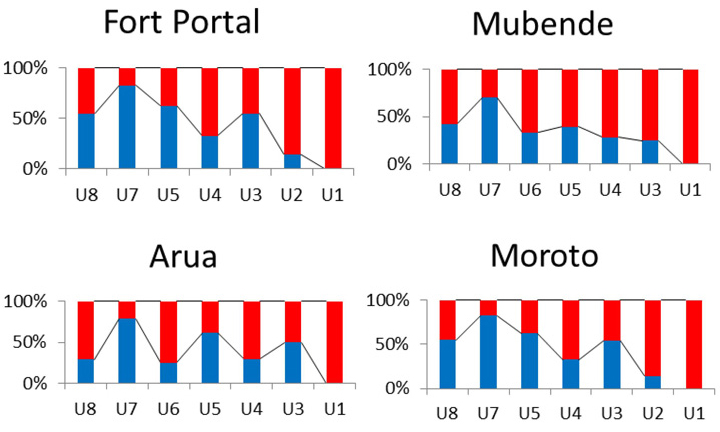
Addressing Gender Inequality in Uganda’s Health Workforce
Constance Newman, senior team lead for gender equality and health at IntraHealth International and for CapacityPlus, presents the following case from Uganda. It demonstrates how IntraHealth’s Uganda Capacity Program is assisting the Uganda Ministry of Health to apply gender research results to improve leadership, governance, and management of the health workforce.
Human resources management policies and practices that promote nonviolence, nondiscrimination, equal opportunity, and gender equality at work result in positive professional work environments and more efficient recruitment, deployment, and retention of human resources for health. However, the gender dimensions of Uganda’s health workforce were largely unexplored. Because of this, the Uganda Capacity Program provided technical support to a Ministry of Health Gender Discrimination and Inequality Analysis (GDIA) to inform gender mainstreaming in the public health sector of Uganda, and in particular, to promote gender equality in workforce policy, planning, development, and human resources management. This supported Uganda’s Gender Policy mandate of “promoting and carrying out gender-oriented research in order to identify gender inequalities1.”
The GDIA assessed gender equality in terms of equal opportunity and equal enjoyment of benefits and privileges of employment by women and men working in the public health sector. The GDIA methodology employed five data collection techniques, including 1) staff and program managers’ surveys; 2) focus group discussions; 3) document reviews; 4) key informant interviews; and 5) the generation of gender reports from the Ministry of Health human resources for health information system (HRHIS).
Key findings included the segregation of women and men into “male” and “female” jobs, and particularly, the concentration of men at the top of occupational hierarchies and of women at the bottom. Data from the HRHIS demonstrated that in eight district health facilities and four national facilities, men occupied 77% of senior management jobs. Sixty-three percent (63%) of middle management jobs were occupied by men. There was also a concentration of men and women in different jobs. Women dominate nursing and midwifery and are concentrated in lower (U5 to U7) employment grades; men dominate clinical services such as medicine and are concentrated in higher (U1 to U4) positions.
These trends were found in four regional hospitals (red indicates men, blue indicates women):

These reports showed that men occupy the highest paid jobs (i.e., a pattern of vertical segregation that has been referred to as the “glass ceiling”) in all four hospitals. This evidence of unequal opportunity demonstrated an associated gender wage gap that is typically linked to this form of discrimination. Focus group data confirmed perceptions of unequal opportunity and male bias in recruitment and promotion practices, especially in promotion to the most senior positions. Unequal opportunity for career advancement for female health workers appeared to be linked to preconceptions of women’s roles or negative beliefs about female managers, as well as to pregnancy and family responsibilities. The lack of family-friendly leave policies raised questions about the efficacy of gender-neutral public sector HR policies and practices because they do not address inequality of opportunity for health workers who have the main responsibility for family care-giving.
As a result of these findings, Uganda’s Ministry of Health adopted a plan to collaborate with the Ministry of Gender, Labor, and Social Development; the Ministry of Public Service; and the Health Service Commission/District Service Commissions responsible for recruitment. The plan includes actions to sensitize and build capacity of key health-sector stakeholders (e.g., Ministry of Health policy-makers, recruiters, district health officers, human resources managers, and facility managers); disseminate GDIA results to district and facility managers and staff; develop an equal opportunity strategy to recruit more women into senior management positions in the public health sector, as provided for in the Ministry of Public Service’s Guidelines for Gender Mainstreaming in HR Management; and integrate ongoing activities to promote equal opportunity and gender equality in district action plans. In April 2013, the Ministry of Health convened a Task Force on Equal Opportunity and Gender Equality to develop a vision, strategy, and indicators for gender equality in the health sector and to disseminate the GDIA reports to a national multisectoral audience.
Related resources
Foundations of Gender Equality in the Health Workforce
This eLearning course produced by CapacityPlus’s HRH Global Resource Center is intended to expose the participant to basic concepts, issues, and standards related to gender equality in the health workforce. Also available in French.
Strengthening the Health Worker Pipeline through Gender-Transformative Strategies
CapacityPlus conducted a systematic review of 300 articles, reports, program documents, and websites on gender discrimination in higher education, including health worker preservice education. A panel of experts in gender and in human resources for health then reviewed summaries of 51 interventions identified from the literature search, according to selected characteristics of gender-transformative interventions. This technical brief provides an overview of how gender discrimination affects health professional students and faculty as well as intervention options that the expert panel identified as having potential to counter gender discrimination. In addition, it offers recommendations for preservice education institutions and other stakeholders to address these challenges. Also see the related report.
Gender and Health Systems Strengthening
This forthcoming eLearning course by CapacityPlus will be made available on USAID’s Global Health eLearning Center.
Gender and Human Resources for Health (HRH) Advocacy Toolkit
This forthcoming toolkit with two interactive modules will assist 1) HRH leaders to identify and respond to gender discrimination in employment systems; and 2) preservice education leaders to identify and respond to gender discrimination in preservice education, based on HRIS gender reports and the CapacityPlus systematic review Transforming the Health Worker Pipeline: Interventions to Eliminate Gender Discrimination in Preservice Education.
1Ministry of Gender, Labour, and Social Development. 2007. National gender policy. Kampala, Uganda: Ministry of Gender, Labour, and Social Development.
The Uganda Capacity Program is funded by USAID and led by IntraHealth International. IntraHealth is the lead partner in the CapacityPlus global project, also funded by USAID.
Help CapacityPlus spread the word about strengthening the health workforce. Follow us on Twitter and like us on Facebook.
Related items:


